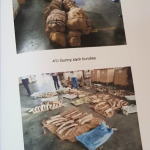Mombasa and Kampala are the epicentre of 26 of the 49 ivory seizures analysed

Links to a number of articles on this new study follow below.
February 23rd, 2022: Professor Samuel Wasser is no stranger to those who investigate or follow international ivory seizures and DNA analysis of those seizures. He has been in the business for over 20 years.
In 2015, Wasser and his team published:”Genetic assignment of large seizures of elephant ivory reveals Africa’s major poaching hotspots”. This was followed in 2018 with: “Combating transnational organized crime by linking multiple large ivory seizures to the same dealer”.
His most recent study has just been published and builds on the foundation provided by the previous reports by expanding his DNA analysis to incorporate study of close family members. This is on the basis that female elephants essentially stay in the same herd for life and even the males who do not stay with the herd, remain in proximity. This expanded analysis is now combined with physical evidence obtained from various law enforcement and NGO investigations to paint a clearer picture of who the African traffickers are, where they are from, and how they operate.
Dr. Wasser et al refer to an evolving “pattern of consecutiveness’, as ivory shipments up to approximately 2009, were originating from northern Mozambique, southern Tanzania and Zambia being containerised in Tanzania and Malawi or Zambia.
In 2010, Kenya became more in involved, with Nairobi and Mombasa seen as points of egress in addition to Dar es Salaam. In mid-2012, Kampala now came into play, containerising both Tanzanian and Kenyan ivory, before initial shipment by road or rail to Mombasa.
In December 2012, a 6 tonne ivory seizure was made in Malaysia that was characterised by something not seen before. The shipment originated in Mombasa with savannah ivory and transited Togo where West African forest elephant ivory was added. This clearly indicated either one criminal group supplying ivory through ports on both sides of the continent or cartels in communication with each other.
In May 2013, a 1.5t ivory seizure in United Arab Emirates was found to originate from Kampala while transiting Mombasa. From this point forward, until 2019 at least, Kampala became the point of origin, if not for ivory, for the logistical organization for many shipments of ivory from both sides of the African continent. Mombasa continued as a preferred port of egress for savannah elephant ivory. This is clearly seen through the genetic matches of ivory and physical evidence obtained. In this study of 49 major ivory seizures, Mombasa and/or Kampala are either port of origin or transit in 26 of them. Although not specifically detailed in the study, the Kampala connection was the West African Cartel under the apparent leadership of Moazu Kromah.
But the West African Cartel also had tentacles in West Africa and the study noted a move from Togo, to Lagos, Nigeria as its west coast consolidation point for forest elephant ivory exports.
Ivory from the Burundi government stockpile was also identified in this study. Ivory seizures made in Kampala, Mombasa, South Sudan and Côte d’Ivoire, the earliest being in 2015, all had quantities of ivory that were believed to be under lock and key.
Prosecutions and convictions were not a feature of this study beyond the hope that the knowledge unearthed may lead to increased success in future investigations and prosecutions.
Sammy Maina Ndirigiri, Fredrick Sababu Mungule, Nicholas Maweu John, Feisal Mohamed Ali, Ephantus Gitongo Mbare, are all Kenyans, charged in Mombasa Courts, allegedly involved in ivory mentioned in this study. They were all acquitted.
But the various shipments for which they were all charged, each prosecuted separately and years apart, were all connected.
Of the 26 seizures analysed, involving Mombasa/Kampala, there has not been one conviction in either involved country.






